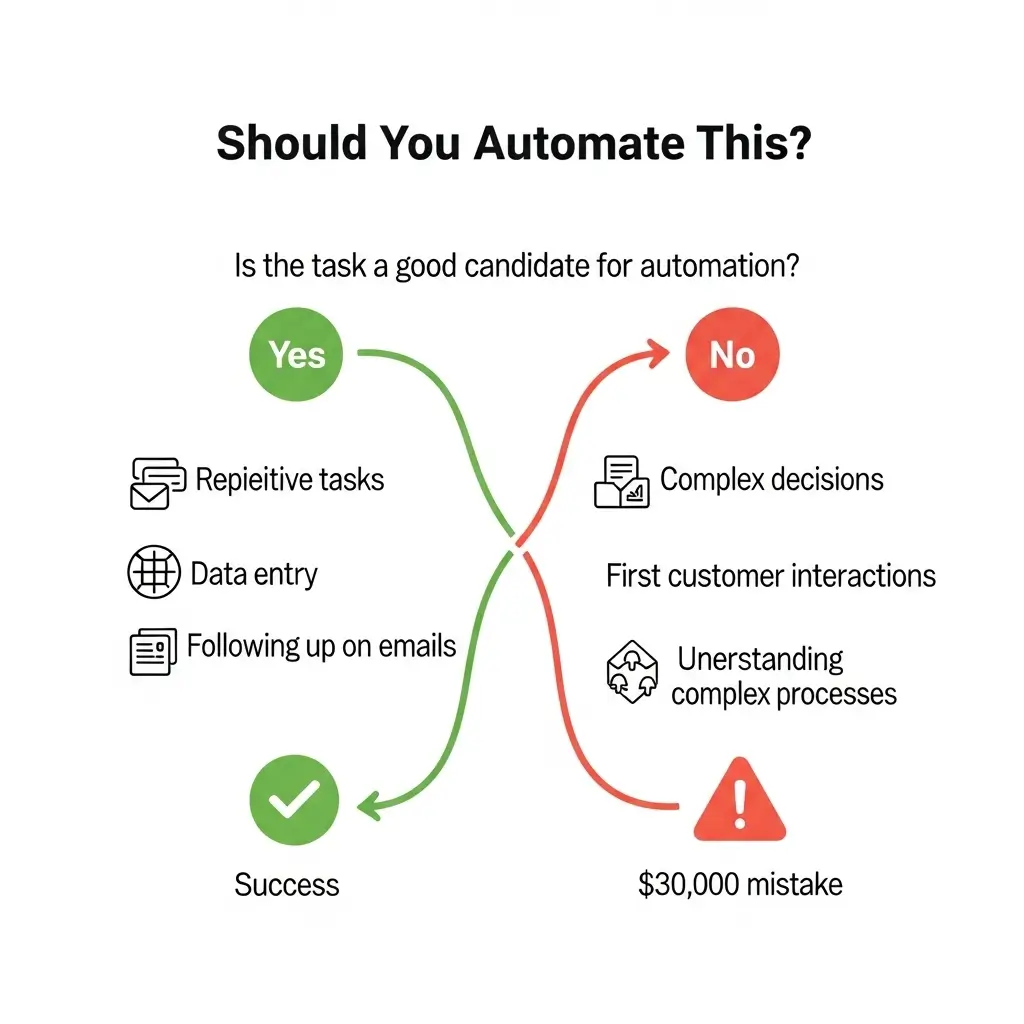Everyone talks about what you should automate. Nobody talks about what you shouldn't. Let me tell you about the time automation cost me $30,000 in dead inventory.
This isn't a story I enjoy telling, but it's one every business owner needs to hear before they go automation-crazy.

The $30,000 Lesson
Picture this: We're running a $17 million annual operation, selling everything from coffee to restaurant supplies. I'm looking at our product sourcing process thinking, "This is taking too much time. Let's automate it."
The manual process was simple enough:
Check Sales
Review what's selling
Analyze Margins
Calculate profitability
Decide Orders
Place purchase orders
So I built an "intelligent" system that would:
- 📊 Track sales velocity across all SKUs
- 💰 Calculate profit margins in real-time
- 🎯 Automatically generate purchase orders based on data
- 🚀 Send orders to suppliers without human intervention
Sounds brilliant, right? Wrong.
Where It All Went Wrong
The system worked perfectly. Too perfectly. It saw that specialty BBQ sauces were selling well in July with 60% margins. The data said "order more." So it did. Lots more.
What the system didn't know: BBQ sauce sales spike in summer for obvious reasons. By the time our automated orders arrived in September, grilling season was over.
We ended up with:
The Three Rules I Learned
That expensive mistake taught me three critical rules about automation:
Rule 1: Don't Automate Complex Decisions
If it requires intuition, market knowledge, or "reading the room," keep humans in the loop. Automation is great for repetitive tasks, terrible for nuanced judgment calls.
Rule 2: Don't Automate First Impressions
Your first touchpoint with customers should be human. Automate the follow-up, the reminders, the thank-yous - but not that initial "How can I help you?" moment.
Rule 3: Don't Automate What You Don't Understand
If you can't clearly explain the manual process, you're not ready to automate it. Automation amplifies existing processes - including their flaws.
What You SHOULD Automate
Don't let my mistake scare you off automation entirely. Here's what actually works:
✅ Perfect for Automation
- Data entry between systems
- Email sequences and follow-ups
- Invoice generation and reminders
- Appointment scheduling
- Report generation
- File organization
- Customer onboarding steps
❌ Keep It Human
- Strategic decisions
- Creative work
- Complex problem-solving
- Relationship building
- Market timing decisions
- Quality assessments
- Anything requiring empathy
The Hybrid Approach That Works
After the BBQ sauce disaster, I rebuilt our ordering system with a hybrid approach:
- ✅ Automation handles: Data gathering, sales reports, margin calculations, suggested orders
- 👤 Humans handle: Final decisions, seasonal adjustments, market intuition, approval before orders go out
Result? We saved 15 hours per week on data gathering while keeping the human judgment that prevents $30,000 mistakes.
Your Action Plan
Before you automate anything, ask yourself:
- 📋 Can I write down the exact steps of this process?
- 🔄 Does this process repeat the same way every time?
- 🎯 Are the success criteria clear and measurable?
- 💡 Does this require creativity or intuition?
- 🤝 Is human connection important here?
If you answered "No" to any of the first three or "Yes" to either of the last two, don't fully automate it. Consider a hybrid approach instead.
Want to Avoid My $30,000 Mistake?
Let's talk about what you should (and shouldn't) automate in your business.
Get Your Free Automation AssessmentTom
Connecticut Business Automation
Built and owned a $17M Amazon business from scratch. Managed IT systems for a restaurant group with 5 locations. Now helping Connecticut small businesses automate the repetitive stuff so they can focus on what actually makes money.
Real Experience:
- Built $17M/year business with 30,000 sq ft warehouse
- Managed IT systems for 5-location restaurant group
- Built automation systems processing 100+ orders daily
- Connecticut business owner helping Connecticut businesses
Tom
Connecticut Business Automation
Built and owned a $17M Amazon business from scratch. Managed IT systems for a restaurant group with 5 locations. Now helping Connecticut small businesses automate the repetitive stuff so they can focus on what actually makes money.
Real Experience:
- Built $17M/year business with 30,000 sq ft warehouse
- Managed IT systems for 5-location restaurant group
- Built automation systems processing 100+ orders daily
- Connecticut business owner helping Connecticut businesses